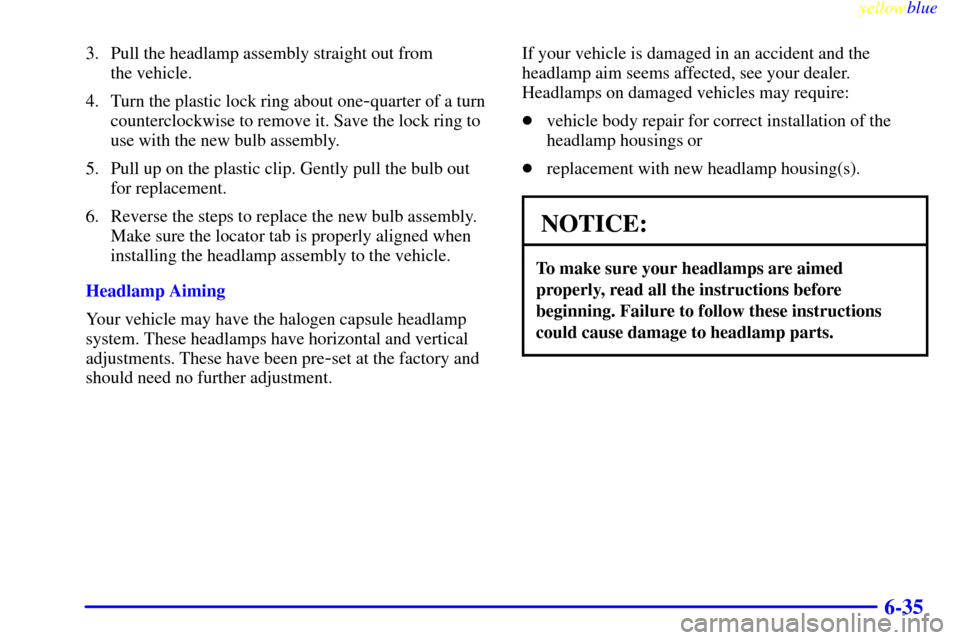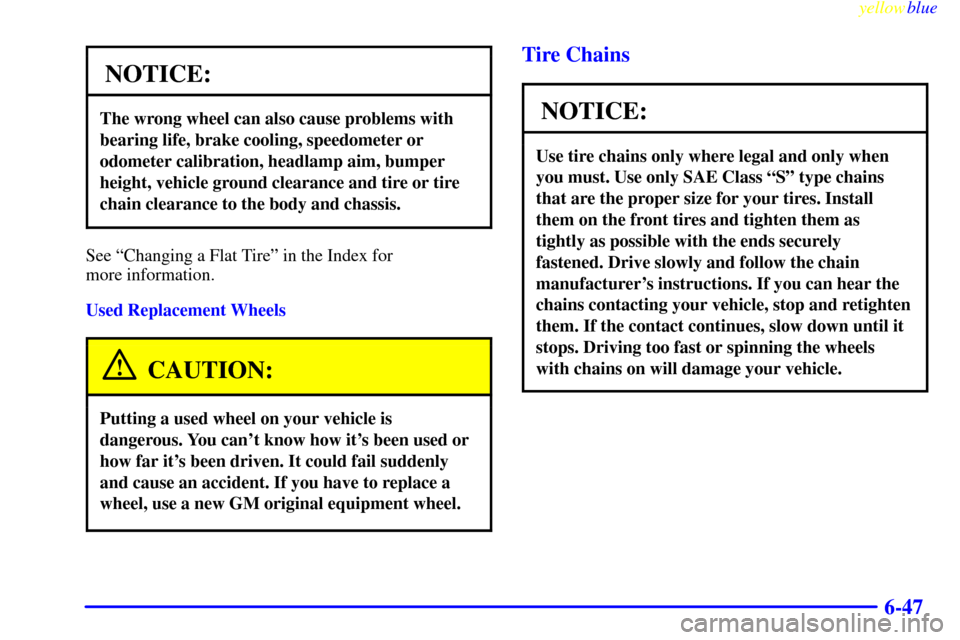Page 226 of 328
yellowblue
6-34
Bulb Replacement
The following procedures tell you how to replace the
bulbs for your vehicle. See ªReplacement Bulbsº in the
Index to check the size and type of bulb you need to use.
For any bulb changing procedure not listed in this section,
contact your Chevrolet dealer's service department.
Halogen Bulbs
CAUTION:
Halogen bulbs have pressurized gas inside and
can burst if you drop or scratch the bulb. You or
others could be injured. Be sure to read and
follow the instructions on the bulb package.
Headlamps
Halogen Capsule Lamps
1. Open the hood.
2. Using a Phillips-head screwdriver, remove the
headlamp assembly mounting screws.
Page 227 of 328

yellowblue
6-35
3. Pull the headlamp assembly straight out from
the vehicle.
4. Turn the plastic lock ring about one
-quarter of a turn
counterclockwise to remove it. Save the lock ring to
use with the new bulb assembly.
5. Pull up on the plastic clip. Gently pull the bulb out
for replacement.
6. Reverse the steps to replace the new bulb assembly.
Make sure the locator tab is properly aligned when
installing the headlamp assembly to the vehicle.
Headlamp Aiming
Your vehicle may have the halogen capsule headlamp
system. These headlamps have horizontal and vertical
adjustments. These have been pre
-set at the factory and
should need no further adjustment.If your vehicle is damaged in an accident and the
headlamp aim seems affected, see your dealer.
Headlamps on damaged vehicles may require:
�vehicle body repair for correct installation of the
headlamp housings or
�replacement with new headlamp housing(s).
NOTICE:
To make sure your headlamps are aimed
properly, read all the instructions before
beginning. Failure to follow these instructions
could cause damage to headlamp parts.
Page 228 of 328

yellowblue
6-36
To check the aim, the vehicle should be properly
prepared as follows:
�The vehicle must have all four tires on a perfectly
level surface.
�If necessary, pads may be used on an uneven surface.
�The vehicle should not have any snow, ice or mud
attached to it.
�The vehicle should be fully assembled and all other
work stopped while headlamp aiming is being done.
�There should not be any cargo or loading of the
vehicle, except it should have a full tank of fuel and
one person or 160 lbs. (75 kg) on the driver's seat.
�Close all doors.
�Tires should be properly inflated.
�Rock the vehicle to stabilize the suspension.
Start with the horizontal aim. The adjustment gear can
be turned with a flat
-head screwdriver.
A. ª0º Mark
B. Center Line
C. Horizontal Aiming Gear
1. Verify that the black line is not at the ª0º mark.
2. Using a flat
-tipped screwdriver, adjust the horizontal
aiming gear until the ª0º mark lines up with
the centerline.
Once the horizontal aim is adjusted, then adjust the
vertical aim.
Page 229 of 328
yellowblue
6-37
A. Vertical Aiming Gear
B. Vertical Indicator
For vertical adjustment:
1. Verify that the bubble is not in the center.
2. Place a flat
-tipped screwdriver into the vertical
adjusting gear.
3. Turn the adjusting gear until the bubble comes to
the center.See your dealer if you need further assistance with
headlamp aiming.
Front Turn Signal/Parking/Sidemarker Lamps
A. Turn Signal
B. Headlamp
C. Sidemarker
1. Open the hood.
2. Using a Phillips
-head screwdriver, remove the
headlamp assembly mounting screws.
3. Pull the headlamp straight out from the vehicle.
Page 239 of 328

yellowblue
6-47
NOTICE:
The wrong wheel can also cause problems with
bearing life, brake cooling, speedometer or
odometer calibration, headlamp aim, bumper
height, vehicle ground clearance and tire or tire
chain clearance to the body and chassis.
See ªChanging a Flat Tireº in the Index for
more information.
Used Replacement Wheels
CAUTION:
Putting a used wheel on your vehicle is
dangerous. You can't know how it's been used or
how far it's been driven. It could fail suddenly
and cause an accident. If you have to replace a
wheel, use a new GM original equipment wheel.
Tire Chains
NOTICE:
Use tire chains only where legal and only when
you must. Use only SAE Class ªSº type chains
that are the proper size for your tires. Install
them on the front tires and tighten them as
tightly as possible with the ends securely
fastened. Drive slowly and follow the chain
manufacturer's instructions. If you can hear the
chains contacting your vehicle, stop and retighten
them. If the contact continues, slow down until it
stops. Driving too fast or spinning the wheels
with chains on will damage your vehicle.
Page 249 of 328

yellowblue
6-57
Electrical System
Add-On Electrical Equipment
NOTICE:
Don't add anything electrical to your vehicle
unless you check with your dealer first. Some
electrical equipment can damage your vehicle
and the damage wouldn't be covered by your
warranty. Some add
-on electrical equipment can
keep other components from working as
they should.
Your vehicle has an air bag system. Before attempting to
add anything electrical to your vehicle, see ªServicing
Your Air Bag
-Equipped Vehicleº in the Index.
Windshield Wiper Fuses
The windshield wiper motor is protected by a circuit
breaker and a fuse. If the motor overheats due to heavy
snow, etc., the wiper will stop until the motor cools. If
the overload is caused by some electrical problem and
not snow, etc., be sure to get it fixed.
Fuses and Circuit Breakers
The wiring circuits in your vehicle are protected from
short circuits by fuses, circuit breakers and thermal links
in the wiring itself. This greatly reduces the chance of
fires caused by electrical problems.
Look at the silver
-colored band inside the fuse. If the
band is broken or melted, replace the fuse. Be sure you
replace a bad fuse with a new one of the correct size.
If you ever have a problem on the road and don't have a
spare fuse, you can borrow one. Just pick some feature
of your vehicle that you can get along without
-- like the
radio or cigarette lighter
-- and use its fuse, if it is the
size you need. Replace it as soon as you can. Before
replacing a fuse, turn every vehicle electrical switch off.
There are two fuse blocks in your vehicle: the engine
compartment fuse block and the instrument panel
fuse block.
Instrument Panel Fuse Block
This fuse box is under the left side of the instrument
panel. To open it, squeeze the short sides and pull off the
cover. The fuses here protect each separate circuit
including headlamps. If you have electrical failure,
check here first.
Page 250 of 328
yellowblue
6-58
Fuse Useage
1 Left Headlamp,
High
-Beam Indicator
2 Right Headlamp
3 Parking Lamps, Sidemarker
Lamps, License Plate Lamps,
Instrument Cluster LightsFuse Useage
4 Door Lock System (If Equipped)
5 Hazard Lamps, Horn
6 Ignition System, Gages, Warning
and Indicator Lights, Automatic
Transaxle Speed Sensor
7 Heater, Air Conditioning
(If Equipped)
8 Stoplamps
9 Lighter, Radio
10 Back
-Up Lamps,
Turn Signal Lamps
11 Rear Defogger (If Equipped)
12 Front and Rear Wiper/Washer
Page 251 of 328
yellowblue
6-59
Engine Compartment Fuse Block
The main fuse box is in your engine compartment on the
driver's side. It protects all electrical loads.
For access to the main fuses, squeeze the tabs on the
sides and pull off the cover.
Fuse Useage
BATT All Electrical Load
ABS ABS System
IG Accessory, Ignition, Windshield
Wipers, Defrost/Defog, Heater,
Back
-Up Lamps
LAMP Taillamps, Stoplamps, Hazard,
Headlamps (right and left)
PTC PTC Heater
FI Fuel Injection
RDTR Radiator Fan Motor
A/C Air Conditioner